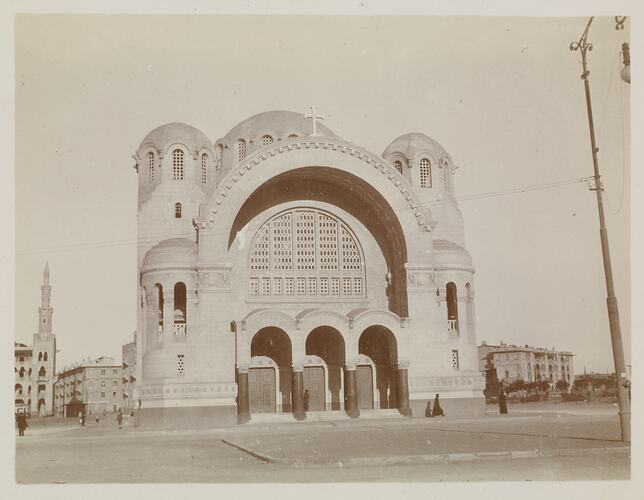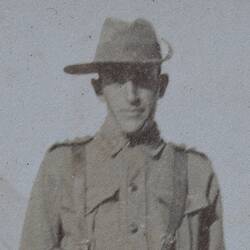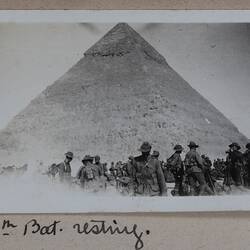Summary
One of 108 images in an album from World War I likely to have been taken by Captain Edward Albert McKenna. The album contains photographs of the 7th Battalion in Egypt.
Image of the Basilica of the Virgin Mary Heliopolis (l'Eglise Notre Dame d'Héliopolis), a Roman Catholic Church dedicated to the Virgin Mary. The church is commonly known as the Basilica of Heliopolis. Building works began on the basilica in 1910 and in 1914 a pipe organ from Beligium was purchased and installed at the basilica. The Basilica of Heliopolis celebrated its centenary in November 2010 and a special concert featuring the restored pipe organ was performed on January 13, 2011.
The modern suburb of Heliopolis was developed in 1905 by the Heliopolis Oasis Company as an upscale district in north-eastern Cairo. According to the written inscription on the back, the postcard shows the 'electric cars' that ran between Cairo and Heliopolis.
The ancient city of Heliopolis (Greek: 'City of the Sun'; Egyptian: Iunu; Biblical: On) is the oldest city in Egypt, located to the north of the ancient capital of Memphis and believed to have been the religious capital in the Old Kingdom. The only remaining remnant of the city is the obelisk of Senwasret I (12th Dynasty, Middle Kingdom) that was originally erected outside the temple of Re-Atum.
The album relates to the service of Captain Edward Albert McKenna. McKenna, born in Castlemaine, Victoria, was a 36-year-old department manager of soft goods when he enlisted on 17 August 1914. He lived at 5 St James Buildings, William Street, Melbourne, and had been married to Elizabeth ('Lillie') Mary McKenna since 1910. He embarked from Melbourne 19 October 1914 on the HMAT Hororata, and served in the 7th Battalion Australian Infantry.
He was killed in action in Gallipoli around 25-30 April 1915, aged 37. His kit bag was unusually full, even containing seven shirts, a pillow, six towels, a travelling rug, gumboots, and pyjamas and slippers. Also amongst his possessions was a camera, although no photographic prints or albums.
He was buried at 7 Lone Pine Cemetery, Gallipoli. His details appear on the honours roll on the web page of the Australian War Memorial.
Description of Content
The photograph shows the Church at Heliopolis. The Church stands rather isolated from other buildings on the street. The front facade consists of one large arch and three smaller arches within the main arch. There are a few people walking around the exterior of the Church and one man who appears to be entering the Church.
Physical Description
Black and white photographic print on paper with a white border.
More Information
-
Collection Names
Returned and Services League (RSL) Collection, Military Memorabilia Collection
-
Collecting Areas
-
Acquisition Information
Donation from Mr J. Willis, circa 1986
-
Acknowledgement
Mr. J. Willis
-
Place & Date Depicted
-
Photographer
Captain Edward A. McKenna - Australian Imperial Force (AIF), Heliopolis, Egypt, 1914-1915
-
Creator
-
Inscriptions
Hand written in ink on the support underneath the photograph: 'Church Heliopolis' Hand written in pencil on the back of the photograph: ' Church at Heliopolis'
-
Classification
-
Category
-
Discipline
-
Type of item
-
Image Dimensions - Photograph
84 mm (Width), 108 mm (Height)
-
Image Dimensions - Photograph album page
174 mm (Width), 141 mm (Height)
Dimensions measurement is of the photograph album page.
-
References
National Archives of Australia: McKenna Edward Albert, barcode 1949283, series B2455/1. 'Heliopolis (Cairo Suburb),' Wikipedia, at: [Link 2]">[Link 1](Cairo_suburb); accessed: August 6, 2012 'Heliopolis (Ancient),' Wikipedia, at: [Link 2]">[Link 1](ancient), accessed: August 6, 2012 Ian Shaw (ed.), The Oxford History of Ancient Egypt, Oxford University Press (Oxford, 2000); p. 86 Ati Metwaly, 'Celebrating the centenary of the Basilica of Heliopolis and the restoration of its rare pipe organ,' Tuesday 11 Jan 2011, AhramOnline, at: [Link 3] accessed: December 19, 2012
-
Keywords


